The best DSLRs in Australia for 2024: top choices for photo and video
The top DSLR cameras for novices, hobbyists and pros
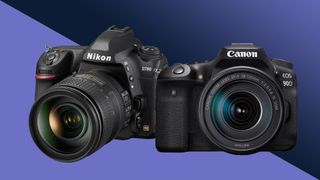
While Canon and Nikon – the only two brands that were making the most popular and best DSLRs for a long time – have focused their efforts on their mirrorless lines, one camera maker still believes in the DSLR: Pentax.
The classic camera brand, now owned by Ricoh Imaging, released the Pentax KF in November 2022, which is a slightly updated version of the Pentax K-70 from 2016. The new features include an upgraded LCD screen and new creative filters. A weather-sealed body houses a stabilised 24.2MP APS-C sensor that performs really well. However, Pentax cameras aren’t widely available in Australia and you will need to visit a specialist store to get one.
- Sharmishta Sarkar, TechRadar Managing Editor (APAC)
It’s no secret that it’s the age of mirrorless when it comes to photography, but you really can’t discount the best DSLRs just yet. Reflex cameras, as they used to be called, are still going strong, although Canon and Nikon haven’t made a new one in a few years. The last DSLR to come from either camera maker was the Nikon D780 in January 2020 – and it’s our pick of the best DSLR you can buy right now in Australia.
The good news is that buying a DSLR right now means you can save some money as most of them have seen price drops over the years and are often discounted at various retailers. They also get significant discounts during big sales. Moreover, they all have a full suite of lenses to choose from, which can always be used if you upgrade to a mirrorless system (of the same brand of course) some time down the line.
So why choose a DSLR in 2023? That’s because the best DSLRs still offer some great benefits like large sensors, fantastic handling and better battery life than their mirrorless cousins. Using an optical viewfinder may also be better for some photographers as they provide an unaltered, unfiltered frame. These features make them a great option for novices and advanced photographers alike. In fact, some DSLRs are the cheapest way to buy a camera with a viewfinder.
Whatever your budget and ability, this list is designed to help you find the best DSLR camera model. Once you’ve decided, you can follow the links beneath each entry for a shortcut to the best deals available right now.
The best DSLRs for 2023
Why you can trust TechRadar
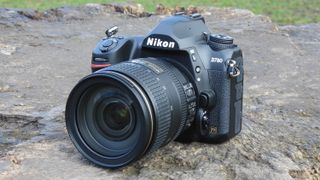
Specifications
Reasons to buy
Reasons to avoid
The D780 is effectively a hybrid of a full-frame DSLR and a mirrorless camera like the original Nikon Z6. And while it's relatively expensive – still selling for its original launch price from 2020 in Australia – it's our top pick because of its excellent performance by virtue of being one of the last DSLRs to be announced. It combines the benefits of mirrorless tech and DSLRs to give you a remarkable snapper.
Building on the solid foundation of the D750, which remains on sale still (see no.8 in this list), the D780 has the same 273-point on-chip phase-detection autofocus system as the Z6. However, it also brings an impressive 2,260-shot battery life, if you prefer to shoot through its optical viewfinder.
We discovered in our review that image quality is among the best around, while its 4K video skills are boosted by the inclusion of modern features like face and eye detection. As a relatively new DSLR, it's still quite pricey, but if that isn't an issue for you, then it's one of the best full-frame all-rounders you can buy.
Read our in-depth Nikon D780 review
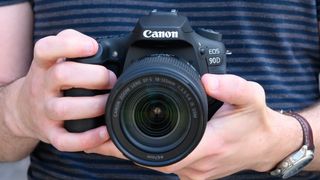
Specifications
Reasons to buy
Reasons to avoid
The EOS 90D is quite the step forward for the EOS DSLR line. It's the first model of its kind to sport a 32.5MP APS-C sensor, which is a generous amount of resolution for both cropping and making large prints. Unlike the earlier 80D, it also has uncropped 4K video recording, while an improved processing engine (when compared to its predecessors) and faster burst shooting are also highlights. The 1,300-shot battery provides far more juice than you'll get from the average mirrorless camera, while protection against dust and water is also a bonus.
In our review, we were impressed by the versatility of the 90D. It's an excellent all-rounder for those who like to photograph a broad range of different subjects.
It's worth weighing up whether the benefits of a mirrorless alternative to the EOS 90D, like the Canon EOS M6 Mark II, might appeal to you. The M6 Mark II is smaller, cheaper and offers faster burst shooting. But by focusing on key areas like battery life, handling and a fully articulating rear screen, Canon has made the EOS 90D a strong and versatile alternative for anyone who prefers the DSLR shooting experience.
Read our in-depth Canon EOS 90D review
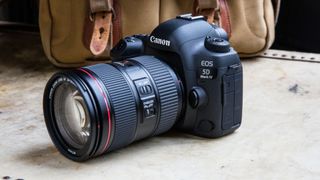
Specifications
Reasons to buy
Reasons to avoid
Canon's EOS 5D series of cameras has a rich heritage – the original EOS 5D brought full-frame photography to the masses, the Mark II unleashed Full HD video capture for the first time on a DSLR, and the Mark III became a firm favourite among photographers for doing everything it did so well.
The EOS 5D Mark IV pretty much tweaks and improves on everything before it, with a 30.4MP sensor and advanced (in comparison) 61-point AF system along with 4K video recording, all of which we found to perform well in our tests. And with a 5D Mark V successor looking very unlikely, it will continue to be one of the most compelling DSLRs at this price point.
Naturally, those 4K video options are a little limited, with the frame-rate topping out at 30fps and no options to shoot in a flat gamma profile. But if you're mainly looking for a powerful DSLR for stills photography, the EOS 5D Mark IV remains a surprisingly modern proposition, considering its age – and the fact that you can still buy it new is a testament to its popularity.
Read our in-depth Canon EOS 5D Mark IV review
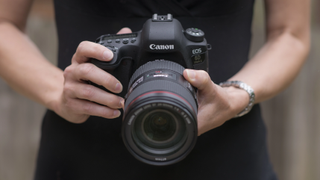
Specifications
Reasons to buy
Reasons to avoid
Although it's a full-frame DSLR, the EOS 6D Mark II is impressively user-friendly. While the chassis can feel rather plasticky, the 26MP sensor housed within is stellar, and offers Canon's trusty Dual Pixel CMOS AF system when using live view mode.
With 45 AF points to choose from and a burst speed of 6.5fps, there's plenty you can capture – including some decent wildlife shots as well. It's not quite fast enough for speedy trackside racing shots, but we discovered in our review that it does surprisingly well for most anything else.
The rear touchscreen also offers tap-to-focus and tap-to-shoot for anyone missing a joystick. Despite that the 6D Mark II is reliable, produces great results and is still a favourite amongst enthusiast photographers.
Read our in-depth Canon EOS 6D Mark II review
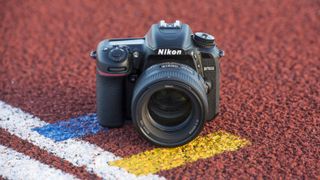
Specifications
Reasons to buy
Reasons to avoid
Fancy the Nikon D500 but don't fancy the price tag? Well, if you're prepared to make a few compromises here and there, the D7500 is what you should be looking at. It's packed with the same 20.9MP sensor as its more senior stablemate, and also matches it in offering 4K video recording.
Nikon also furnished it with the same 180k-pixel RGB metering sensor and the tilting screen on the back is just as large at 3.2 inches in size, although not quite as detailed, and it's all wrapped up inside a weather-sealed body. In our tests, we were impressed by a number of things, including battery life, image quality and handling. It's a great all-rounder for those with a healthy amount of budget.
On an even tighter budget? There's also the older 24.2MP Nikon D7200, which continues to offer great value – it is still possible to find stock at some retailers in Australia.
Read our in-depth Nikon D7500 review
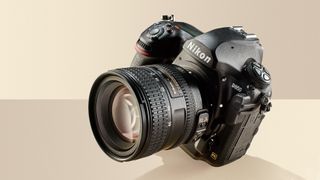
Specifications
Reasons to buy
Reasons to avoid
It's hard to think of another DSLR that wows like the D850 does, even after several years on the market. It's on the pricey side for sure, and bulky too, but this is justified by the things we discovered in our tests, including excellent image quality, bags of features and a rugged, weather-resistant magnesium alloy body. The 45MP sensor is still one of the highest in terms of resolution in any DSLR, while the 7fps burst mode is unusually high for a camera with such a sensor. Add to that a cracking AF system, wonderful handling and great 4K video, and its versatility should be easy to appreciate.
Like the sound of the D850, but want to go mirrorless? Well, while not strictly a mirrorless version of the D850, Nikon's Z7 mirrorless camera shares the same 45MP resolution as the D850, but features some clever tech of its own, including the new Z lens mount.
Read our in-depth Nikon D850 review
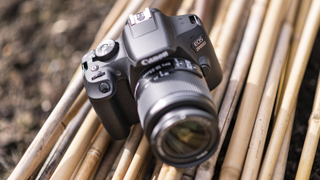
Specifications
Reasons to buy
Reasons to avoid
If you’re buying your first DSLR camera on a tight budget, a simpler, slightly older model is the way to go. Canon’s entry-level EOS 1500D (known as the EOS 2000D in Europe) fits that bill: the specs won’t blow anyone away, but we found it easy to use and that it gets the basics right. And, because it’s a few years old, it offers fantastic value at a more approachable price point.
There are several compromises, of course. Burst shooting is limited to a lazy 3fps and the dated autofocus system features just nine points. Live View focusing is sluggish and you’ll need to look elsewhere if you want a touchscreen. And, as you’d expect, the plasticky shell does not feel premium.
But there are good points for beginners, too. We felt the control layout is logical and easy to use, and battery life is solid. There’s video recording too, albeit limited to 1080p. More importantly, in our tests the 24.1MP sensor produced images with a good level of detail and decent dynamic range, while noise performance is solid. If you’re looking to buy a good DSLR on a shoestring, the EOS 1500D is well worth considering.
Read our in-depth Canon EOS 2000D / 1500D review
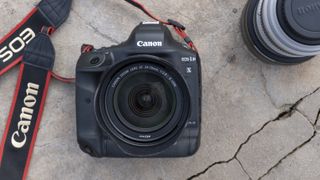
Specifications
Reasons to buy
Reasons to avoid
If we're talking about the best DSLRs on paper alone, then it's hard to walk past Canon's latest and greatest – the EOS 1D X Mark III. Designed specifically for the pros who need speed, performance and quality together in one neat package, the 1D X Mark III pretty much covers it all. It can easily handle any situation you want, whether in the sports arena, shooting wildlife or for a photojournalist in a war zone.
A rugged body, 20fps burst speed, an AF system that we found can rival Sony's, and image quality that really doesn't need a lot of post-production editing are just some of its excellent qualities. And if you thought it was meant only for stills, think again. Its video prowess is handy too, with 4K/60p capture available on board using the full width of the sensor.
All in all we were - as expected - extremely impressed with what the 1DX Mark III can achieve. The only downside? It's expensive (and possibly overkill) for the average photographer, and that's why it manages to tumble this far down the list. Nonetheless, it does manage to stand out as a more-than-worthy investment for professionals and the most passionate photography hobbyists to consider.
Read our in-depth Canon EOS 1D X Mark III review
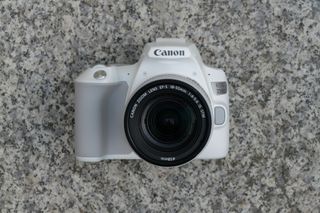
Specifications
Reasons to buy
Reasons to avoid
Canon's budget DSLR, the 200D Mark II (also known as the Rebel SL3 in the US and EOS 250D in Europe) mixes a strong feature set with great handling despite its small size.
The 200D Mark II also adds 4K shooting to its now discontinued predecessor, although this is cropped and rolling shutter is often noticeable. Still, as we discovered in our in-depth test, it does offer pleasing JPEGs, a superb 1,070-shot battery life and compatibility with a huge range of EF lenses that most mirrorless cameras lack. If those features are top of your camera wishlist, and you're on a tight budget, then this beginner-friendly DSLR remains a compelling choice and would be our recommendation for budding young photographers to learn the ropes.
Read our in-depth Canon EOS 250D / 200D Mark II review
How to choose the best DSLR for you
A DSLR remains the cheapest way to get a camera with interchangeable lenses and a viewfinder (you’ll find many entry-level mirrorless cameras don’t have viewfinders). But what else should you consider when choosing one?
The main differences between an entry-level DSLR and a more advanced one are in the camera’s design, sensor and shooting features. Beginner DSLRs are often smaller than their more premium equivalents. This has historically made them some of the best travel cameras around, though it usually also means a lack of weather-proofing and fewer manual controls.
The size difference is often also related to sensor format. More affordable DSLRs tend to have APS-C format sensors, while pro-friendly ones like the Nikon D850 are full-frame cameras. You can see a diagram showing the difference in sensor sizes below.
There is no outright ‘better’ sensor size, with each having its own advantages and drawbacks. To find out more about these, check out our guide on how to buy a full-frame camera.
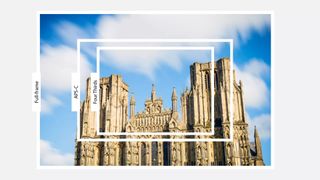
Not sure how to decide between a beginner DSLR and a mid-range model? Paying a bit more for the latter will usually get you increased shooting flexibility, which could see you keep the camera for longer and save you money in the long run. The extra features you tend to get are improved continuous shooting speeds (handy for shooting sport or wildlife), superior high ISO performance (useful in lower light), and sometimes an extra memory card slot.
If you’re just looking to step up from your smartphone or point-and-shoot camera, though, then an entry-level DSLR will give you the image quality boost and manual controls you need to grow into your new hobby. Finally, a quick word of advice if you don’t have any lenses – buy your new DSLR with a kit lens, as it’s cheaper to do this than buy them separately.
What is a DSLR camera exactly?
Like most modern cameras, a DSLR allows you to record still images to a memory card. What makes a DSLR camera different is the way that it directs light to the sensor inside. DSLR stands for digital single-lens reflex camera. Breaking that down, the ‘digital’ refers to the sensor. This can be anything from a standard APS-C sensor, all the way through full-frame to the much larger medium format.
‘Single-lens’ is fairly self-explanatory: it means that DSLR cameras use one and the same lens to frame, focus and shoot photographs. Almost all cameras do this nowadays, but the terminology is a hangover from the days when retro rangefinder and twin-lens-reflex models used multiple lenses to achieve the different functions (think of vintage Rolleiflex cameras here).
‘Reflex’ refers to arguably the most important component of a DSLR camera. It means that a mirror inside the body directs the light coming down the lens. When you’re framing a shot, this light is sent to the optical viewfinder, giving you a true analogue impression of the scene. But when you press the shutter button to start an exposure, this mirror will flip up. In an analogue SLR camera, this would expose the film inside. In a DSLR, it allows the digital sensor to capture the available light.
Besides the optical viewfinder, another benefit of this reflective system is that DSLR cameras have to be larger than their mirrorless equivalents. This might sound like a downside, but it means DSLR cameras can benefit from famously good ergonomics. DSLR cameras also support interchangeable lenses, so you can switch to more suitable glass when you need to shoot a different scene – from a prime lens to a zoom lens, for example. And because the format has been around for so long, you should have no trouble finding compatible lenses and accessories.
For a more detailed explainer on how DSLRs compare to their mirrorless counterparts, check out our in-depth Mirrorless vs DSLR comparison feature.
How we test cameras
Buying a camera these days is a big investment, so every camera in this guide has been tested extensively by us. These days, real-world tests are the most revealing way to understand a camera's performance and character, so we focus heavily on those, along with standardised tests for factors like ISO performance.
To start with, we look at the camera's design, handling and controls to get a sense of what kind of photographer it's aimed at and who would most enjoy shooting with it. When we take it out on a shoot, we'll use it both handheld and on a tripod to get a sense of where its strengths lie, and test its startup speed.
When it comes to performance, we use a formatted SD card (either UHS-1 speed or UHS-II depending on the model) and shoot in both raw and JPEG (if available). For burst shooting tests, we dial in our regular test settings (1/250 sec, ISO 200, continuous AF) and shoot a series of frames in front of a stopwatch to see if it lives up to its claimed speeds. We'll also look at how quickly the buffer clears and repeat the test for both raw and JPEG files.
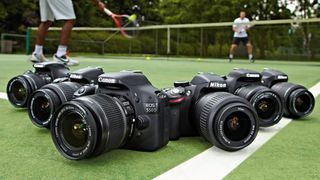
In various lighting conditions, we also test the camera's different autofocus modes (including Face and Eye AF) in single point, area and continuous modes. We also shoot a range of photos of different styles (portrait, landscape, low light, macro/close-up) in raw and JPEG to get a sense of metering and its sensor's ability to handle noise and resolve fine detail.
If the camera's raw files are supported by Adobe Camera Raw, we'll also process some test images to see how we can push areas like shadow recovery. And we'll also test its ISO performance across the whole range to get a sense of the levels we'd be happy to push the camera to.
Battery life is tested in a real-world fashion, as we use the camera over the course of the day with the screen set to the default settings. Once the battery has reached zero, we'll then count the number of shots to see how it compares to the camera's CIPA rating. Finally, we test the camera's video skills by shooting some test footage at different frame-rates and resolutions, along with its companion app.
We then take everything we've learned about the camera and factor in its price to get a sense of the value-for-money it offers, before reaching our final verdict.
Get the best Black Friday deals direct to your inbox, plus news, reviews, and more.
Sign up to be the first to know about unmissable Black Friday deals on top tech, plus get all your favorite TechRadar content.

Mark is TechRadar's Senior news editor. Having worked in tech journalism for a ludicrous 17 years, Mark is now attempting to break the world record for the number of camera bags hoarded by one person. He was previously Cameras Editor at both TechRadar and Trusted Reviews, Acting editor on Stuff.tv, as well as Features editor and Reviews editor on Stuff magazine. As a freelancer, he's contributed to titles including The Sunday Times, FourFourTwo and Arena. And in a former life, he also won The Daily Telegraph's Young Sportswriter of the Year. But that was before he discovered the strange joys of getting up at 4am for a photo shoot in London's Square Mile.
- James CutlerStaff Writer
- Sharmishta SarkarManaging Editor (APAC)